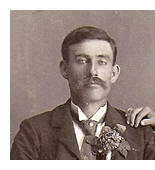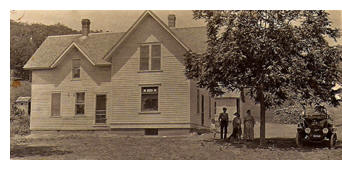|
Biographical Sketch of Eugene Burton Fleming
Believed to have been written by Elsie Ellen Fleming
Eugene Berton (sic) was born at Pepin Feb. 3 1871, being
the fifth child. He spent the greater part of his life here and attended the Hicks Valley sch school, but when in his teens he went to Dak. Where he
spent several years, returning home in his early twenties.
here and attended the Hicks Valley sch school, but when in his teens he went to Dak. Where he
spent several years, returning home in his early twenties.
On June 10, 1896 he was married to Miss Eva Wheeler also
of Pepin, Wis.
For a time they lived in Hicks Valley where Altha M. was
born Feb. 23, 1900, on the old Fleming farm on upper end
of the valley. Later
they moved to Plum Creek on the David Boyd farm, where Altha
died on Jan. 4, 1903. Later they lost much of their home
furnishings by fire.
They then bought the Old Rowley property east of Potato Hill
where they built up a home. But, while still on the Boyd place
Elsie Ellen was born
Jan, 8- 1904.
In Jan 13. 1910 Elvin was born. Later a little daughter
Dorothy was born Nov. 6. 1915 but living a very short time
passed on the same day. Eva
lived till Nov. 24 when she too passed away.
On June 5. 1917 Bert was married to Gertrude Gray of Dakota.
“Bert”, as he was called, managed to obtain about 6 years of
education before along with an older brother Milton (Ebb),
becoming the primary
labor force on the John Fleming home farm. Bert may also
have spent a short time doing farm work somewhere in Berlin,
North Dakota.
Recollections of Elvin G. Fleming (son), and Elvin
E. Fleming (grandson) 1998
On 10 June 1896, Bert married Eva Almyra Wheeler (born 21 July
1875) daughter of Gilbert L. and Ellen M. (Nichols) Wheeler
also residents
of the Town of Pepin, Pepin County, Wisconsin. Bert and Eva
had five children of which two, Elsie and Elvin, survived
childhood and lived
well into their nineties.
A house fire on his first rented farm in Plum Creek,
Town of Frankfurt, caused Bert to have fear of fire
and led to his restarting to farm in
the Town of Pepin in Circa 1906 on 160 acres in section 29, town
23, range 14W, just east of “Potato Hill”. The summer of 1915 is as good as it got. The scene is on the
south side of the east ridge a quarter of a mile off the local
landmark known as
‘Potato Hill’ or more popularly, “Spud Hump”. At left in
the background is an out house. The right hand wing of the
house is new. In the
right background is seen part of a detached garage situated on
a higher level of the hill. Pic Pictured from left: Elvin G., age 5; Bert; Elsie, age
11; and Eva.
The many young Walnut trees that grew on the farm gave the
farm it’s name, ‘Walnut Grove Farm’. At right is a new, 1915
Maxwell.
Whenever he could, Bert parked his automobiles front
first down hill, preferably on a fairly steep slope to
enable starting it without having to
crank it by hand or later, use the starter. To the
immediate right there is a dug-out road wrapping around a
point of the hill leading to the fields with heavy loam soil on top and in back of the
hill. The other farm buildings were located off the
photo to the right, and the larger sandy fields
lay to the south and southeast, mostly across the town
road.
There, on the “Walnut Grove Farm”, Bert remained for the rest
of his life.
The summer of 1915 is as good as it got. The scene is on the
south side of the east ridge a quarter of a mile off the local
landmark known as
‘Potato Hill’ or more popularly, “Spud Hump”. At left in
the background is an out house. The right hand wing of the
house is new. In the
right background is seen part of a detached garage situated on
a higher level of the hill. Pic Pictured from left: Elvin G., age 5; Bert; Elsie, age
11; and Eva.
The many young Walnut trees that grew on the farm gave the
farm it’s name, ‘Walnut Grove Farm’. At right is a new, 1915
Maxwell.
Whenever he could, Bert parked his automobiles front
first down hill, preferably on a fairly steep slope to
enable starting it without having to
crank it by hand or later, use the starter. To the
immediate right there is a dug-out road wrapping around a
point of the hill leading to the fields with heavy loam soil on top and in back of the
hill. The other farm buildings were located off the
photo to the right, and the larger sandy fields
lay to the south and southeast, mostly across the town
road.
There, on the “Walnut Grove Farm”, Bert remained for the rest
of his life.
Eva’s death 25 November 1915 left Bert with an
11 year old daughter (Elsie) and a 5 year old son (Elvin)
to raise. For a brief time after Eva’s death, Mabel
Fleming, widow of Bert’s brother James, and her three
sons, Clint, Jack, and Dick helped out. Eventually Bert
advertised for and accepted a housekeeper, Gertrude Grey
(born 9 October 1874). They were latter married.
Much of Bert’s personality reflected a 19th century outlook.
For most tasks, he choose hand labor over mechanization. Folk
lore took the place
of science and dictated such things as; potato had to be
planted in the correct phase of the moon and corn could
not be planted until the Maple
leaves were the size of a squirrels ear. Bert was
rarely heard to utter a conventional swear word, but
freely used a lexicon of colorful expletives such as;
“aye-gad!”, “lickety-whoa-bob!”, “to beat sixty!” and
etc.. In like manner, Bert, along with many of his generation had
difficulty adjusting to the onset of the mechanical age, much
the same as adults have difficulty adjusting to the onset of
personal computer technology at the end of the 20th century.
Bert could never master the synchronization of the engine
speed and the clutch. Starting out always involved a big lurch
or as cars became more powerful, the spinning of wheels, digging
ruts or on soft soils, getting stuck. For that purpose, he
always carried a come-a-long with which by hooking onto a nearby
tree, he could pull himself out.
Bert valued work for its own
sake and what it accomplished, mattered less. It seemed that
he would deliberately choose to do things the hard way.
At one time, Bert owned a portable ‘saw rig’, for cutting logs
crosswise in 16 to 18 inch lengths to be used for firewood.
The rig consisted of one of those single cylinder, four cycle
engines with two large, external flywheels to keep up the
momentum between when the engine fired in a put - - - put - -
- put - - - fashion. The saw was on one end of a shaft on
which another flywheel and pulley was found on the other end of
the shaft. The saw was driven by a belt from a pulley on one
of the flywheels on the engine. The engine was cranked with a
handle on the opposite flywheel. Bert never took the time to
properly align the two pulleys, but rather, drove steel stakes
in strategic places to guide the belt so it would not fly
off either of the pulleys. Since the engine was easier to
start if it were not also turning the saw, Bert would start the
engine first, then put the belt on the spinning pulley with
his shoulder. One day, the pulley and belt grabbed his jacket
and a back portion of Bert’s shoulder. It jerked him off his
feet, flipped him over and slammed him to the ground,
miraculously without impaling him on one of those stakes. A
swelling developed on Bert’s shoulder and eventually he
consulted a doctor about it. But Bert refused to pay what he
considered to be an exorbitant fee for having it taken care
of, and the swelling continued to grow. Eventually, it grew to
about 6 inches wide and 4 inches high tapering down the back of
his shoulder to his waist. From one profile, he appeared
hump backed even though his posture was remarkably erect. A
slim man, he always wore ‘braces’ (suspenders) which served
to emphasis the appearance of the growth on the one side of
his back.
Bert and Gertie retired on a 10 acre tract in the southwestern
corner of the farm -- the part that had been the horse pasture
and a camping ground for passing bands of Indians and later,
Gypsies, the same part where Elvin G. Fleming would eventually
build his retirement home. Here a cow, some chickens,
berry patches, apple and plumb trees, a kitchen and a vegetable
garden kept them busy between occasional fishing outings in the
backwaters of the Chippewa and Mississippi, and in the bower
pits along the Pepin to Nelson and Nelson to Wabasha dike
roads. Short trips to pick blueberries or to shop in Durand
or Wabasha along with occasional trips to visit his daughter,
Elsie Ellen (Fleming) Baumgarten at Morristown, MN rounded
out their lives.
Gertrude died 22 January 1952 and in the night of 21-22
December 1955, Eugene Burton Fleming died in his sleep
ironically from smoke inhalation as his house caught fire,
probably from the accumulation of creosote in the chimney
caused by Berts overly cautious habit of choking down fires
in the heating stove. |